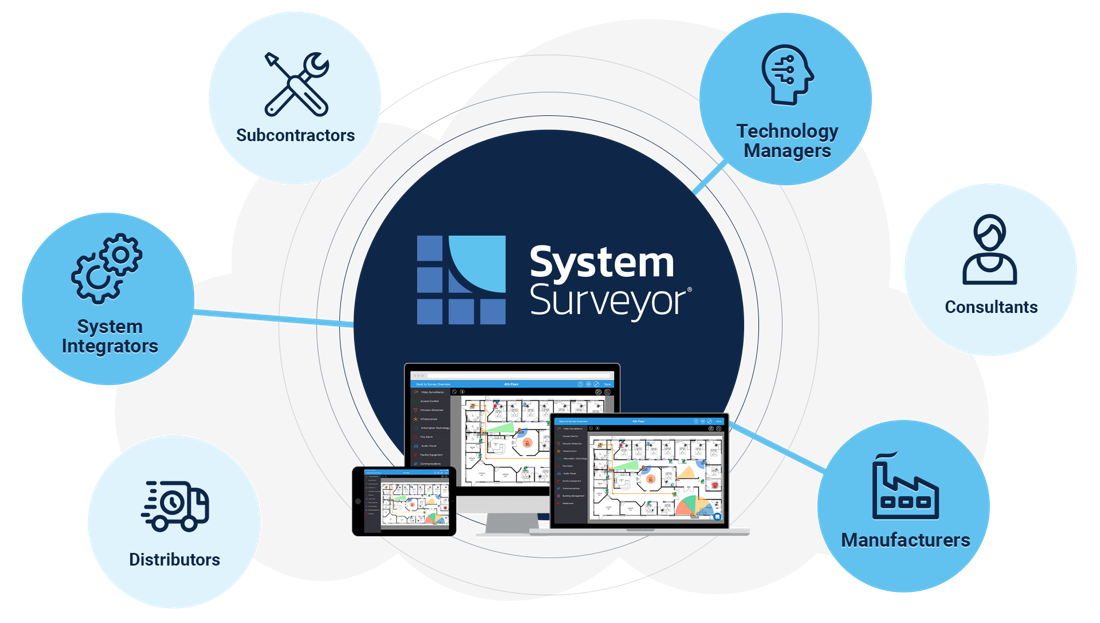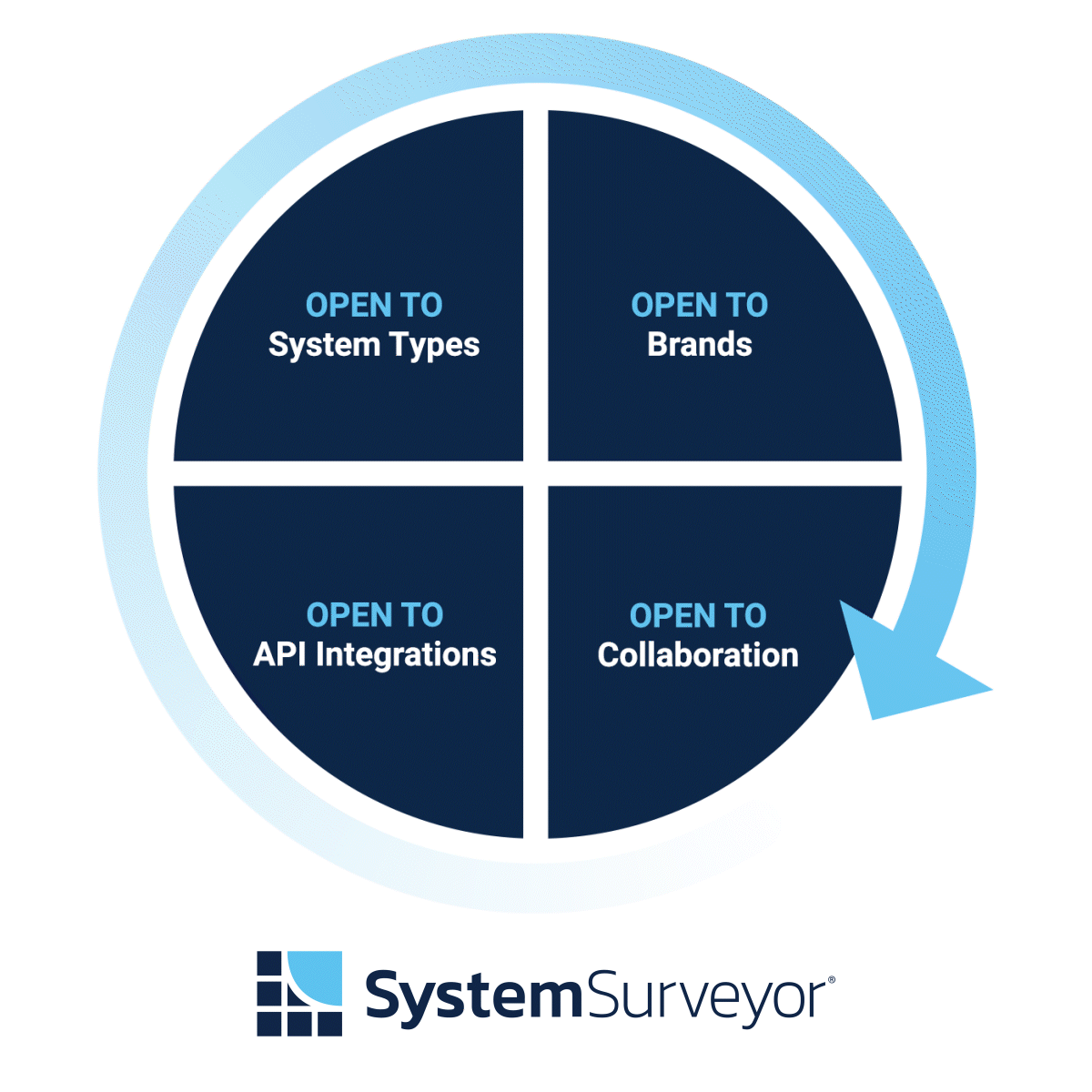An Open Platform Provides Our Industry the Freedom to Design Better Systems.
This is a topic that we’re passionate about at System Surveyor. To us, the future of physical security and IoT system design is open. Being “open” allows System Integrators and other solutions providers the freedom to use a variety of technologies to solve a problem.
That might sound like a strange thing to say about an industry known for keeping people out and keeping doors closed, but it’s true.
Open system design software is the next evolution for the physical security industry. We’ll show you four reasons this is the case in today’s post.
What Does “Open” Mean, Exactly?
Before we go any further, you might be wondering what exactly we mean by “open”. Fair question: The term is fairly, well, open-ended.
When we talk about an “open platform” for security system design, we mean a software application that is open from four perspectives:
1. Open for drag-and-drop design of various system types such as video surveillance, access control, lighting, intrusion detection, cabling, building automation etc.
2. Open to various brands for devices and technologies from a variety of manufacturers or vendors.
3. Open for integration to other software programs to streamline workflows using an API.
4. Open for collaboration with all of the experts in the ecosystem that are part of a design, delivery, and maintenance of systems; not to mention collaboration with customers, stakeholders, public safety and the broader group of people involved in the process.
If a single open application that allows you to design all physical security components regardless of type or manufacturer — and collaborate as you do so — sounds like a pipe dream, then we should chat. Not to toot our own horn, but this is exactly what System Surveyor does. More on that later.
For now, let’s look at how four specific pieces of being an open platform that will advance the digital transformation of the physical security industry. These provide the freedom to create better systems made up of that interdependent group of items or devices.
System Surveyor: An Open System Design Platform
1. Open to System Types

Any single physical security system, from video surveillance to access control and so on, is not a single standalone piece of hardware. It is a “system” made up of multiple devices and components working together to solve a problem or a use case.
Take video surveillance cameras — a staple in the physical security industry for obvious reasons. A security camera by itself is useless. Without cabling, mounting hardware, a cloud or on-premises solution for storing and viewing footage, and a few other elements, the camera does nothing.
And let’s go one step further: most organizations implement more than just one system. When it comes time to work with system integrators on an upgrade, they may want to upgrade video surveillance cameras, access control, fire alarm system, and cabling all at once.
Newer technologies and providers such as SoundSecure (audio to complement video footage) and Iluminar (lighting to ensure video functionality) are built to work with and enhance the effectiveness of video surveillance as well.
To truly enable digital transformation and future growth, a system design platform must be open to all system types to create “solutions”. It’s possible to find security system design software that can’t account for access control or cabling or intrusion detection or IoT sensors (you get the idea). But these tools are inherently limited: to get the results you need you would have to use a half dozen different software tools.
2. Open to Brands
Just like with systems, brands in physical security are rarely monolithic. While it may be possible in certain circumstances to build an entire cohesive system from a single brand, this is rarely a real-world reality. There are just too many parts and pieces, including “boring” stuff like cabling and conduit, for a single brand to be the best choice for everything.
If this is true, then manufacturer-made design tools immediately pose a challenge. For very understandable reasons, a given brand’s system design tool will tend to focus on its own products. They may go deep but they have a harder time going wide to help develop an integrated solution.
In the real world, this just doesn’t work. Not for campus and corporate physical security leaders, and not for system integrators.
That’s because the best systems and solutions typically involve technology from multiple system types and multiple vendors.
The ability to provide and design cross-brand solutions provides greater freedom to solve complex security problems and to build smarter buildings. There is no doubt about the benefits of standardizing on some brands that work cohesively together (take for example, Google’s Nest and Home platform for residential) but rarely is there one brand that does it all.
Example: University Campus
Today’s universities face significant physical security design challenges. They must secure and monitor multiple buildings and building types as well as outdoor spaces. They’re also rarely building a system from scratch. They already have a preferred brand for CCTV cameras, and they may also have preferences for VMS, access control, motion detectors, sensors and other system components.
Campus physical security teams must compete with other teams for funding, and often those other teams have flashier, sexier, more interesting projects. Everyone knows physical security is important, but when stakeholders decide budgets, it’s easy to disregard the things that no one sees.
With an open system design platform, physical security leaders can showcase a comprehensive security system design and plan to stakeholders, making the physical security component more visible. University campus security managers that use System Surveyor tell us they can provide a better visual to show the plan, share the budgetary numbers and share the needs with their vendors and integrators more efficiently to get their recommendations and quotes.
System Integrators: Become a True Solutions Provider
System integrators are using an open system design platform to become problem-solvers and solutions providers. With one platform that can handle all system types and all brands (or their favorite, go-to brands), they can build the best solutions for their customers regardless of what interrelated technology is needed and the best products to solve the problem.
Remember, customers don’t choose you for specific hardware preferences. They choose partners who provide solutions. System Surveyor empowers this type of consulting and guidance.
Leading system integrators use a collaborative design platform to help close the sale: by showing your prospect or customer a holistic solution — one that accurately represents all parts and pieces with no compromises or limits — you help the client gain a more complete vision for what that system can do. The most likely result? Greater buy-in.
3. Open to Collaboration
Next, the future-focused open system design platform must be open to collaboration. No one organization has all the expertise or resources to design, implement, install, and maintain every aspect of a comprehensive physical security system. How many of you use subcontractors? Case in point!
In the design process alone, the customer, public safety, integrators, manufacturer vendors, and even architects and engineers all have valuable contributions (or at least opinions) to share.
In the old way of doing things, all of this information — if it was gathered at all — happened in manual processes, such as pen-and-paper notes taken during the site survey and PDFs sent insecurely via email
But with modern collaboration-oriented design software, all parties in the ecosystem can directly and securely interact with the system design and management, at a level of detail beyond anything the pen-and-paper process could imagine.
When your system design platform is open to collaboration, you can streamline communication and delivery, and you can truly interact and collaborate in ways you couldn’t before. This includes intra and inter-company collaboration that the cloud supports in ways we did not have 10 years ago. For example, if you have ever worked on Google Docs or SharePoint, you can securely share documents and collaborate without the trail of emails. The same concept holds true here on a floor plan or design with different levels of read and write or read-only collaboration. And, seek a platform that allows for Guest Users and different privileges even for unlicensed folks in your ecosystem.
System Surveyor Acts as a Collaboration Platform for the Industry Ecosystem

Rely on the Experts
As new technologies come to the market such as AI and machine learning, video analytics, and touchless access control, vendors are vital to the discussion. They understand their products at a deeper level, making them experts in areas that the typical integrator may not be YET.
Collaboration with customers, integrators, and vendor experts is wise. Otherwise, your organization (or your customers) could miss out on the promise of these technologies.
This collaboration works most seamlessly when your system design platform itself is open to secure collaboration.
4. Open to API Integrations
Today’s businesses are more connected (and more interconnected) than ever before. Chances are that your organization is already using some mix of project management software, a CRM platform, and accounting or ERP, customer service software. (System integrators, the same goes for your clients.) Similarly, you’re probably already using chat and collaboration apps like Slack or Teams, and the list goes on.
With the proliferation of software tools comes a new problem: how to get those tools to talk to one another. The answer in many cases is the application programming interface, or API.
Software tools use APIs to allow access to elements within the software, with relatively minimal coding or development required. And some platforms offer an entire marketplace of prebuilt API integrations (think of the way Slack integrates with Google Drive and vice versa, for example).
How does this matter for system design? Here’s an example. An integrator might use System Surveyor for pre-sales design and site surveys. Out of that work the integrator can create a proposal, but the client may need that proposal to run through their ERP to order the components. Without integration, someone has to manually input all that data into the ERP. With the integration, it can happen instantly.
The first step is for the development community to have open, well-documented access to an API. Learn more here about the System Surveyor API to integrate your favorite applications. Interested in guiding the future of System Surveyor’s API marketplace? Please take this survey to share what you’d like to integrate.
System Surveyor is the clear alternative that positions you for future growth. Our open system design platform can handle all system types, giving both corporate physical security leaders and system integrators the tool that they need to build the best solutions.
System Surveyor: Providing the Freedom to Design Better Systems
These four aspects of being open provide the freedom for customers and their partners to design and manage better systems and solutions. It is not sustainable or scalable for every single system device and every single manufacturer to have a design tool – many are already overloaded. It is one of the core reasons that System Surveyor “came to be” and it keeps evolving.
Over time, our vision is to ensure it is the community’s platform empowering professionals to design more efficiently and intelligently, leveraging each other’s profound experience. How exciting is that?
Meanwhile, as we deliver on these pillars of openness, we also strive to keep applications easy to use, approachable, and valuable to everyone in the process (not just engineers). When we can bridge those expertise gaps, we can deliver on the true promise of technology to provide safety, security and elegant intelligent buildings.
Not a System Surveyor customer yet? There’s never been a better time to start. See how our open system design platform gives users the freedom to design better systems. Request your System Surveyor demo today!

Maureen Carlson is co-founder and president of System Surveyor, the leading digital platform for physical-security site surveys and system design. With 25 + years in B2B SaaS and security technology, she leads the go-to-market and operations with a top notch team. Under her leadership, System Surveyor has grown into an industry-defining software used worldwide to streamline system design, enable collaboration, and raise the bar for security and technology professionals. Maureen enjoys building relationships in the industry and user community to build sustainable, high growth business. In her spare time in beautiful Austin, you’ll find her spending time outdoors, on a tennis court, reading or with family and friends.
